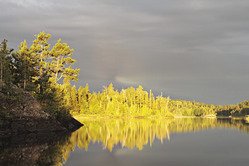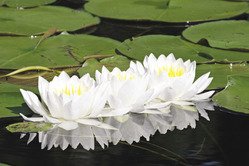It may come as a surprise to many people, but the Boundary Waters and Quetico are really not great locations for wildlife photography! Why?
These vast wilderness areas are largely boreal forest, a habitat type that has relatively low densities of wildlife, and of those species that live there, most have large territories. Consequently, finding critters to photograph often depends upon luck – just being in the right place at the right time. Round a bend, and there might be a moose, or a family of otters, or a bald eagle perched on a limb. Such events are hard to repeat, and difficult to predict. My advice? Be prepared!

If you hope to photograph wildlife on your canoe trip, first you must be quiet. If you are traveling in a group that likes to chat between canoes, or has a member with the annoying habit of banging the side of the canoe with a paddle, I think you can pretty much forget about seeing much wildlife. Second, you must have your camera gear out and ready. I know that frightens people, but I can guarantee you that it will be a very rare occasion that you’ll have the time to dig your camera out of a waterproof pack. Most subjects simply won’t wait that long.
You can, however, TRY to predict where animals might be – and when. Almost all canoe country wildlife is most active in the early morning and late evening. It has also been my experience that areas with some marsh associated with it – slow, meandering streams, weedy back bays – tend to be most attractive to animals. There you might encounter moose, or otters, and some of the waterfowl species that nest here, like the secretive Ring-necked duck, or Black ducks. Let the noisy paddler sleep in while you sneak slowly along quiet shores, and you’re bound to find something at which to point your camera.
I have to admit, though, that when I’m on a canoe trip, I tend to photograph subjects other than wildlife. Although I make no claim to be a great landscape photographer, I take many of them while on canoe trips. The lakes and rivers beg for panoramic photos.

As a wildlife photographer, I rarely use lens filters, but while in canoe country, I consider a polarizing filter a must for daytime photos. These filters tend to darken the blue of the sky, make the white clouds pop, take glare off the rippling waves, and allow the camera to penetrate below the water’s surface. For sunrise or sunset shots, take the polarizer off, though. Instead, to deepen the intensity of these beautiful colors, try under-exposing the scene by anywhere from 1/3rd to one-full stop.
On those gray days that give photographers fits because no matter how you photograph the landscape it looks “blah”, turn your attention to macro-photography. The canoe country is home to an amazing variety of mosses, lichens, berries, and fungus. The flat light of a gray day is perfect for these subjects. I like to use my telephoto lens for many of these images, although it does force me to step back quite a distance to do so. One of the unique features of a telephoto lens is that it beautifully blurs the background – an effect called “bokeh” – which focuses the viewer’s attention on the subject.
Make sure you pack plenty of batteries and extra memory cards. As I upgrade cards, I never toss the older, smaller capacity cards, because they make great backups on canoe trips. Better to be shooting to an old, slow card than not shooting at all!
My final advice is to play with angles. Climb that ridge and shoot down and across the lake. Try photographing scenes from just above the water’s surface for an interesting perspective. Lay on the ground to capture the moss or lichen.
Yes, finding a moose or bear or otter to photograph in the canoe country is mostly pure, dumb luck. Fortunately, the landscape itself, and the amazing diversity of plants, will provide you with more than enough subjects to keep any photographer busy and happy.


